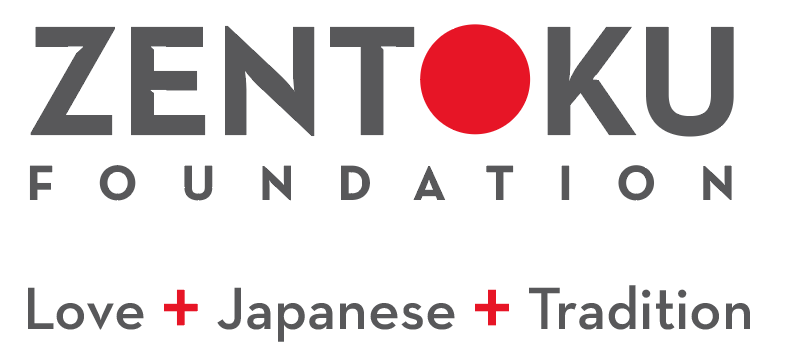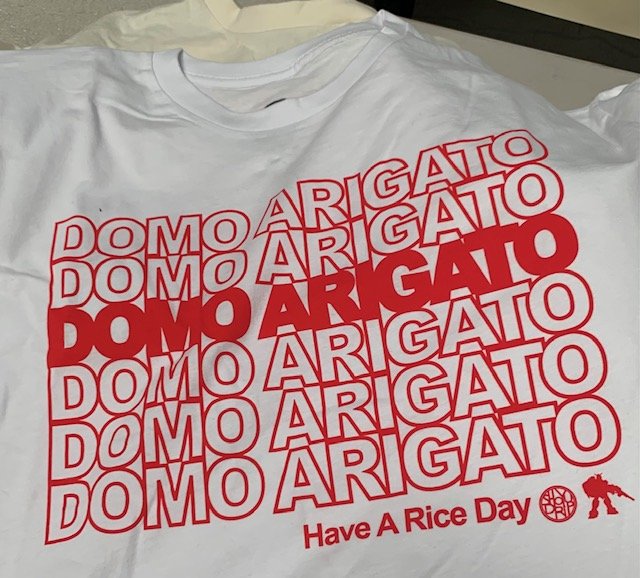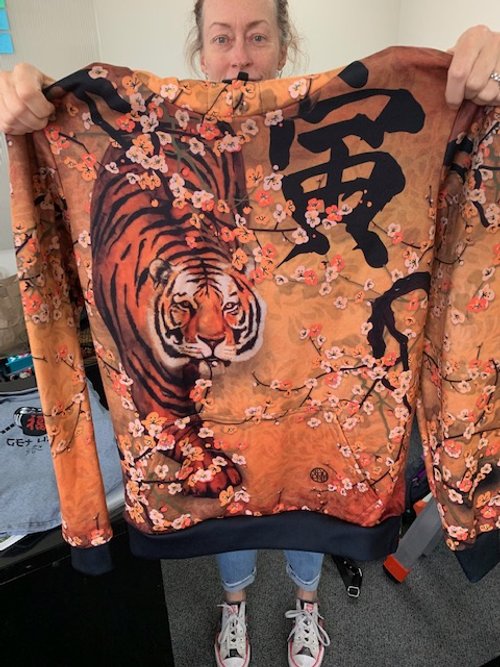Rob Tsuyuki and ShoyuDrip - Influenced by the Japanese Culture
By soji kashiwagi
One look at the Japanese American creator of ShoyuDrip, an internet apparel company featuring modern-day fashion with a distinctive Japanese flavor, and you’d probably never guess that he once considered himself a “non-Japanese.”
But for Sansei Rob Tsuyuki, 55, this was basically who he was for a good part of his life.
“Both of my parents tried to raise me as non-Japanese as possible,” Tsuyuki said, sitting in his office/warehouse near Angels Stadium in Anaheim.
Born in Los Angeles but raised with his two older sisters in suburban Orange County, he soon became used to being one of maybe two Asian kids in his classes. “It was very white. I was always different. I was raised as non-Japanese. I didn’t speak Japanese. I didn’t go to Japanese churches. It was hard. That’s a whole part of me.”
It was a part of him that definitely led to some internal and external conflicts. Being Japanese at school, he never really felt like he fit in. At Japanese American family gatherings, he felt like he didn’t belong there either.
“It was weird to be at a gathering and you don’t know what the family members are saying,” he said. “Grandma would speak in Japanese, and everyone knew what she was saying.”
Except Rob, who never learned Japanese because that’s not who he was -- at least according to his mom and dad. But after a while, he had to point out an obvious fact to his parents: “Look at me,” he said. “You can raise me as a (white) American. But I look Japanese.”
He didn’t know it at the time, but his parents had their reasons for raising their kids the way they did. As a teenager, his father, Dr. Theodore Tsuyuki, was taken with the rest of his family and community and incarcerated at the WWII American concentration camp in Poston, Arizona. His mother, Sadako (aka “Sadie”), was younger than his father, and spent the war years with her family first at Tule Lake, then at the Heart Mountain camp in Wyoming.
Like many Nisei, the trauma from that experience deeply affected them as people, and how they went on to raise their children. It also didn’t help that upon their release from camp, Tsuyuki’s parents and the rest of the Nisei generation were explicitly told by U.S. government officials not to speak Japanese, gather with other Japanese Americans and to move away from their former West Coast homes and settle in other states.
This assimilation into American culture led some Nisei to deny their “Japaneseness” and to raise their kids as 200% American as possible. But the elder Tsuyuki could not let go of the wrong committed against him and his community.
“I know my dad was pissed off until the day he died,” Tsuyuki said. “He went to UCLA and USC, graduated with honors, went to medical school way faster than normal. He was very determined to do something. He was bitter. When they got the $20,000 (in redress payments), that just set him off. He was insulted by the amount and upset that it was his parents who should have received it.”
Rob’s parents Sadie and Ted Tsuyuki
Tsuyuki’s mother, on the other hand, remembered the upheaval caused by two government-issued “loyalty questions” imposed upon all Japanese Americans in camp, ages 18 or over. Question 27 asked if Japanese Americans would serve in the U.S. military on combat duty “wherever ordered.” Question 28 asked if Japanese Americans would swear unqualified allegiance to the U.S. and fore swear any form of allegiance to the Emperor of Japan.
Both questions created chaos and unrest in the camps, and led to a split between those who answered the questions “Yes-Yes” versus those who answered “No-No.” It’s a split, unfortunately, that still exists within the Japanese American community to this day, some 80 years after the “questions of loyalty” were first asked.
Tsuyuki suspects that his mother feared the incarceration of Japanese Americans might happen again, and if it did, she wanted her children to be completely “American” who didn’t speak Japanese or know anyone in Japan. That way, the government could never question their loyalty, or have any doubts that they were nothing but full-blooded Americans.
And so he became a “non-Japanese.”
“I was the true ‘banana,’” he said, referring to the term used to describe an Asian person as “yellow on the outside, white on the inside.”
Little did he know at the time that many other Sansei were raised the same way he was—for the same or similar reasons.
As a youth, he did have some exposure to the Japanese American community by playing on an Anaheim Methodist Church JA basketball team, and attended Nisei Week and annual Obon festivals.
“But it was very part time,” he said.
Instead, thanks to the influence of his mother, he started to dabble in art from an early age. He did everything from throwing pottery to airbrushing to painting on canvas. Ever since he was young, he always enjoyed building and creating things.
“My mom always painted and then took up calligraphy and became pretty well known in that community,” Tsuyuki said. “Both my sisters were always very artistic. I guess I was always around art, but never really thought I was good enough to be an artist. So when I discovered graphic design, around my teenage years, it really appealed to me. Typography was and still is very intriguing to me.”
He liked it so much that he decided that he wanted to pursue art as a career. His father was surprisingly supportive, Tsuyuki said, but his mother warned him that “artists starve.”
Megan and Rob in the early days.
He enrolled at the ArtCenter College of Design in Pasadena to study graphics and packaging, and eventually ended up at the Academy of Art in San Francisco in 1991, where he learned how to put his graphics onto film and video. It was in San Francisco where he met his future wife, Megan, on a video project, which led them to team up to start a new internet company.
Working together led to romance, and the couple got married in 1998, and will be celebrating their 25th anniversary in 2023.
“We were lucky to be a part of the dot.com boom (1995-2000),” Tsuyuki said. He was the company’s graphic designer where he worked on the first three versions of AOL’s instant messenger sound, and created corporate logos, including AOL’s Running Man Logo.
It wasn’t until his first visit to Japan in 1996 that he started to find a connection and realize the separation he had from his Japanese roots. “I felt like I didn’t know any Japanese, but I recognized all the food,” he said.
“In Japan, it really made me feel embarrassed that I couldn’t communicate with the people, yet I’m Japanese. They expect Japanese to come out of my mouth—I just remember the look on their faces when I spoke to them in English. But it was the first time I felt like I didn’t stand out in the crowd, and I was taller than everyone else.”
Megan and Rob with their children, Kainoa and Mordecai
After moving back to Southern California, the Tsuyukis had their first son, Kainoa, in 2003, and a second child, Mordecai, in 2006. During this time, the couple decided to take some time off from work to raise their kids. It was also during this time that Tsuyuki realized he didn’t want to raise his kids the same way he had been raised.
He started teaching them about Japanese culture, and to be proud of who they are as Japanese Americans.
In 2008, the couple returned to work by starting Ink and Burn, a running apparel company they ran until 2022. With “Art on Apparel” as their tagline, Ink and Burn became known in the marathon and long-distance running world for its bold and colorful designs on shirts and running wear where the colors never faded and stayed breathable throughout a grueling 26-mile marathon.
Although they created multiple designs, one common theme throughout its fashion line was an unmistakable Japanese influence and flavor, something that Rob intentionally created.
“All of our pieces had stories, a unique name and story behind it,” Rob said. “People got that. We had a big following for our art. It always had a Japanese influence. So it was an easy transition to go from Ink and Burn to ShoyuDrip.”
After their landlord raised their rent by 50% and with the rising costs of doing business, the couple realized they couldn’t continue Ink and Burn. In December 2021, they launched their ShoyuDrip website, and began selling and sharing Rob’s love for all things Japanese.
“I love the food, and I wanted to share and talk about Japanese American culture. The street wear. Up until now, there hasn’t been a clothing company that connects to me as a Japanese American.”
That’s what the couple hopes ShoyuDrip will become, as well as connecting to other non-Japanese Americans as well.
On its website, the mission of ShoyuDrip tells you what they’re all about:
“ShoyuDrip is a small group of artists and designers who want to raise awareness and appreciation of Asian culture using art, design, humor and food. To do this we create comfortable, affordable and cool street wear that features art with a dash of Japanese flavor.”
Over the past year, ShoyuDrip has come out with custom-made Japanese-themed t-shirts, hapi hoodies, bucket hats, yoga mats, blankets, zipper pouches, water bottes, fanny packs and a line of products called “Mottainai,” based on the Japanese/JA tradition of not being wasteful.
“I remember my grandma saying that all the time,” Rob said.
They’ve also added a ‘fun food” line of clothing featuring shirts with large, colorful bowls of ramen, a sushi invaders women’s t-shirt, and a taiyaki wave unisex shirt. Other collections include Year of the Rabbit fashions, koi fish, maneki neko, Japanese-inspired wave and sea creatures, origami, flowers, dragonflies, dragons and butterflies.
Some products with a uniquely JA spin include logos with plays on Japanese and English words including ‘IrashaiWelcome,” “Eatadakimasu” “Konnichhiwasssubi” “Seeyanara” and “Rocky” Sticks instead of Pocky Sticks. There’s also “Don’t Touch My Mustache,” which is Rob’s humorous spin on “Douitashimashite.” (“You’re welcome.”)
“I love humor. I love clever things. Having fun with Japanese and English is who I am—a mixture of both.”
Mottainai (lose Japanese translation is wasteful) appreciates the value of things and encourages you to find new uses, thus Rob makes jackets out of old scrap material.
Rob said ShoyuDrip definitely targets a Japanese American audience, but also crosses over with the large crowd of people who are into all things Japanese such as anime, manga and foods like ramen and sushi.
“We want to appeal to everybody,” he said. “I would love for it to be for the JA community. I like to think we have stuff for my kid’s age to my sister and for my mom’s age. We want to hit everyone. Our products speak to a wide range of people.”
After just more than a year, 99% of ShoyuDrip’s business is from its website sales with orders coming in from across the U.S., Canada, the Netherlands and Japan. Thanks to the advice and input from the Tsuyuki’s young sons, ShoyuDrip is also on Facebook, Instagram, Twitter, TikTok and YouTube. They’re also looking to expand in-person sales with appearances at various community events and Japanese festivals.
“It’s fun to share and reach people through art and clothing,” he said.
Ideas and inspiration, he said, come from everywhere – Japanese stories, for instance, or Japanese patterns.
All of this from the guy who once considered himself a “non-Japanese.”
Now, he’s all about being Japanese and American, and teaching others about the cultures.
“We love doing things that educate others,” he said. “Most of our stuff have stories behind it, and the symbolism behind the art. We’re teaching people about Japanese culture and we’re learning about it at the same time.”
What makes him happiest, though, is that his children love Japan and everything Japanese. His son studied Japanese in college and can speak it without an American accent.
“My son knows so much more than I do,” Rob said. “I don’t know if I’m playing catch up. I’ve accepted how I was raised, but we’re not raising our kids that way. I wish it was different, but I don’t fault my parents. I am proud of who I am and what we’ve accomplished.”
As for learning the Japanese language himself, Rob said it’s on his list of things to do. “It’s never too late,” he said.
Note: ShoyuDrip’s fashions including its men’s line of t-shirts, golf polo shirts, hapi hoodies and Mottainai items were featured at the annual So-Phi’s Annual Fashion Show, Luncheon and Boutique in late March of 2023. For info on ShoyuDrip, check out their website at https://shoyudrip.com















